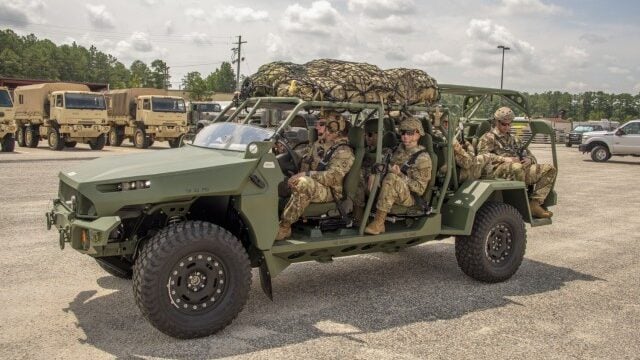
Paratroopers prepare to depart for a 50-kilometer road test in a fully loaded ISV after modifying airdrop rigging techniques because of structural and mechanical changes. (Army/Michael Zigmond)
WASHINGTON — GM Defense has received the greenlight to move into full-rate production of the US Army’s new air-droppable troop carrier, dubbed the Infantry Squad Vehicle (ISV), the service announced on Tuesday.
That announcement comes after Army officials postponed the milestone decision last year in order to retest the vehicle to determine if a number of undefined “deficiencies” had been corrected.
“The ISV has been rigorously tested, including production qualification testing and transportability certification, which included low-velocity air drops and helicopter sling loading,” the service wrote in a press release posted online. “Reliability testing concluded earlier this year, which completed the ISV production qualification test,” it later added.
To date, the Army has accepted more than 300 ISVs and fielded 177 of those, or three brigade sets with 59 vehicles in each, with plans to field another two brigade sets in June.
The Army’s longer-term plan, though, is to ultimately acquire 2,593 ISVs, and this week’s announcement could lead to a higher production rate to get there, eventually. Until at least September, GM plans to continue delivering 20 ISVs to the Army each month, a spokesperson told Breaking Defense.
Fiscal 2024 budget documents also do not indicate service plans to immediately ramp up ISV production. Last year at this time the Army told lawmakers it planned to buy 183 ISVs in FY24, but the service has only asked lawmakers for $36 million next year to buy 143, 40 fewer vehicles than predicted. That figure then fluctuates between 109 and 148 ISVs each year between 2025 and 2027 before it spikes to 171 in 2028.
GM Defense won the service’s $214 million ISV contract in 2020 with a proposal based around the Chevrolet Colorado ZR2 midsize truck that can be transported via a CH-47 Chinook helicopter and airdropped by the C-17 Globemaster and C-130 Hercules aircraft.
While the Army didn’t say which deficiencies it had worked to correct most recently, over the subsequent years, the Pentagon’s chief weapons tester has raised questions about the vehicle that the service and company said they have addressed.
In the FY21 Director, Operational Test & Evaluation (DOT&E) report, for example, the office said that when the vehicle was tested in Yuma Proving Ground, Ariz., desert conditions in 2021, testers found problems with broken seat frames, engine cracks and overheating. The service subsequently said it would address some of those issues.
“The Army took deliberate action to shift the [full-rate production] FRP decision [from May 2022] to March/April 2023 to allow time to validate corrective actions implemented by the vehicle manufacturer to address deficiencies identified during developmental and operational testing,” John Hufstedler, the product director for ground mobility vehicles with the Program Executive Office Combat Support & Combat Service Support, wrote in a Jan 27 email to Breaking Defense.
The GM Defense spokesperson wrote in a Jan 30 email that all issues identified at Yuma had been addressed in coordination with the Army and a new vehicle was provided to re-run the reliability, availability and maintainability testing.
“There were no mission failures or system aborts from the last round of testing,” the spokesperson added. Completion and analysis of this reliability testing paved the way for the Army’s new full-rate production.
Army eyes TBI monitoring, wearable tech for soldiers in high-risk billets
“We are also looking at what additional personal protective equipment we can provide to our folks, especially instructors and others who are routinely exposed to blast pressure,” said Army Secretary Christine Wormuth.


























